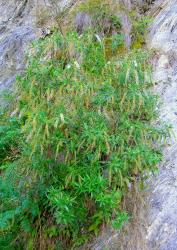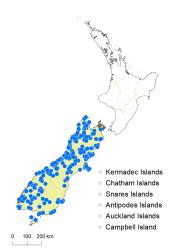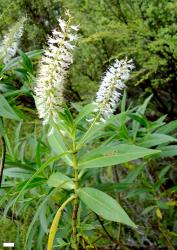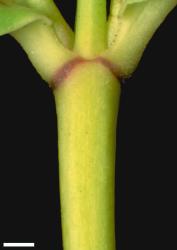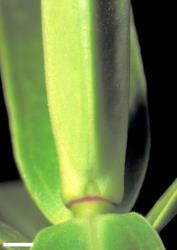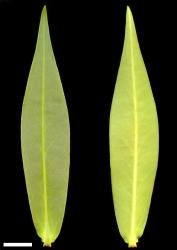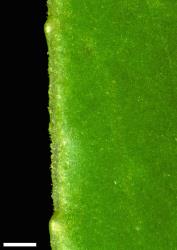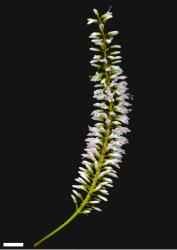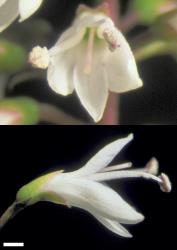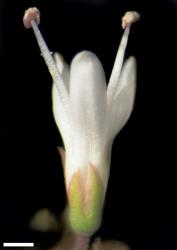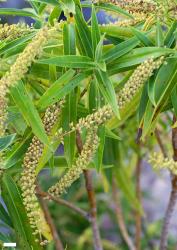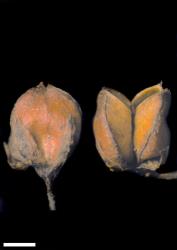- ≡ Panoxis salicifolia (G.Forst.) Raf., Med. Fl. 109 (1830) nom. illeg.
- ≡ Hebe salicifolia (G.Forst.) Pennell, Rhodora 23: 39 (1921)
- = Veronica fonkii Phil., Linnaea 29: 110 (1857)
- ≡ Hebe fonkii (Phil.) Cockayne & Allan, Trans. New Zealand Inst. 57: 21 (1926)
- = Veronica salicifolia var. communis Cockayne, Trans. New Zealand Inst. 48: 201 (1916)
- ≡ Hebe salicifolia var. communis (Cockayne) Cockayne & Allan, Trans. New Zealand Inst. 57: 17 (1926)
Tall, bushy or open shrub to 2.5 m tall. Stems erect, eglandular-puberulent or glabrous; hairs bifarious to uniform. Leaf bud distinct, its leaves appressed at margins until fully grown; sinus broadly ovate to broadly elliptic. Leaves opposite-decussate, erecto-patent; lamina sub-coriaceous, narrowly lanceolate to narrowly oblanceolate, 35–130 mm long, 6–28 mm wide, somewhat glossy green above, dull pale green beneath; midrib and secondary veins evident; surfaces with eglandular hairs along midrib above and often beneath, sometimes also with minute glandular hairs; margin ciliolate, cartilaginous, entire or with up to 12 pairs of distant, minute teeth; apex acuminate; base truncate; petiole 1–5 mm long. Inflorescence a lateral raceme, 50–230 mm long; flowers crowded, 100–250, all bisexual; bracts alternate or loosely whorled, linear to lanceolate, < pedicels; pedicels spreading, sometimes recurved at fruiting, 0.7–4.7 mm long, puberulent all around. Calyx lobes 4, sub-acute to acuminate, 1.5–3.0 mm long, equal, mixed eglandular- and glandular-ciliolate. Corolla 3–5 mm diameter; tube white, 2.5–3.2 mm long, > calyx, eglandular-hairy within; lobes 4, white or pale purplish, sub-equal, erect or erecto-patent, lanceolate, 3–5 mm long, acute to rounded; nectar guides absent. Stamen filaments white, 5.0–8.5 mm long; anthers magenta or purplish. Style glabrous, 4–7 mm long. Capsules latiseptate, sub-acute or obtuse, glabrous, 2.5–3.5 mm long, 2.5–3.0 mm at widest point. Seeds broadly ellipsoid to discoid, flattened, smooth, straw-yellow, 0.6–1.1 mm long.
Veronica salicifolia is common throughout the South Island (except Marlborough Sounds and inland South Canterbury and Otago) and Stewart I. Over most of that range there is no species it might be confused with.
In lowland Westland, V. phormiiphila plants are very similar to V. salicifolia and they may grow in close proximity. Plants of V. phormiiphila differ in their narrower and more evenly tapered leaves. V. phormiiphila plants have puberulent stems, whereas stems of V. salicifolia plants may be glabrous or puberulent. V. phormiiphila plants are found in wetlands, often in standing water, whereas V. salicifolia plants are mostly found on better-drained sites.
In the north of the South Island, V. stricta plants may be readily distinguished by lacking a sinus in the bud. The two species appear to overlap in distribution along the east coast of Marlborough and North Canterbury.
South Island: throughout except Marlborough Sounds and areas of inland South Canterbury and Otago.
Stewart I. (west coast), Auckland I. (the single record is considered to be a recent introduction: WELT SP098720, Johnson & Campbell 1975; see Bayly & Kellow 2006).
Open sites, scrub, and in forest, especially forest margins. Recorded elevations range from 0 to 1067 m.
Also indigenous to southern Chile; naturalised in coastal sites in W. Europe (Walters & Webb, in Tutin et al. 1972).
(see Garnock-Jones 2008).
Hybridises extensively with V. elliptica where they co-exist (see V. ×lewisii). Synonyms for this cross include V. ×amabilis, V. ×blanda, V. salicifolia var. gracilis, and V. ×ellipsala.
V. salicifolia × calcicola (Bayly et al. 2001)
V. salicifolia × albicans (Bayly & Kellow 2006)
V. salicifolia × strictissima (Bayly & Kellow 2006, Wilson, WELT SP101295)
V. ×erecta is thought to be a garden hybrid between V. salicifolia and V. pimeleoides. V. dartonii is a wild collection thought to be of the same origin.
V. ×kirkii is probably a hybrid between V. salicifolia and a small-leaved species, probably V. rakaiensis.
V. ×leiosala is thought to be the hybrid of V. salicifolia and V. leiophylla.
Flowers: December–June, or occasionally in October, November, and July; fruits: January–June, or occasionally November and July.
2n = 40 (see Bayly & Kellow 2006, as Hebe salicifolia).
Veronica salicifolia is classified in V. subg. Pseudoveronica sect. Hebe and the informal group “Apertae” (large-leaved) (Albach & Meudt 2010; Bayly & Kellow 2006).
The leaf teeth in V. salicifolia and similar plants are distant, minute, thickened hydathodes along the leaf margin. Larger teeth, similar to those found in speedwell hebes like V. lanceolata, are seen in seedlings and juvenile plants.



